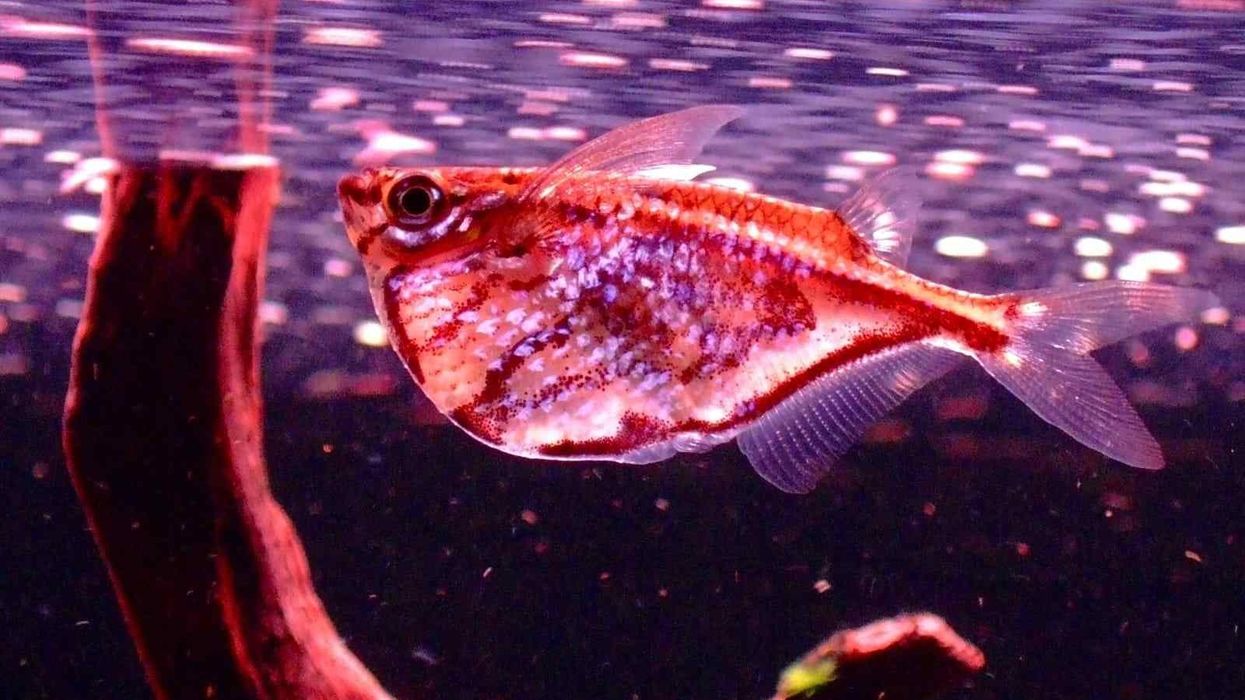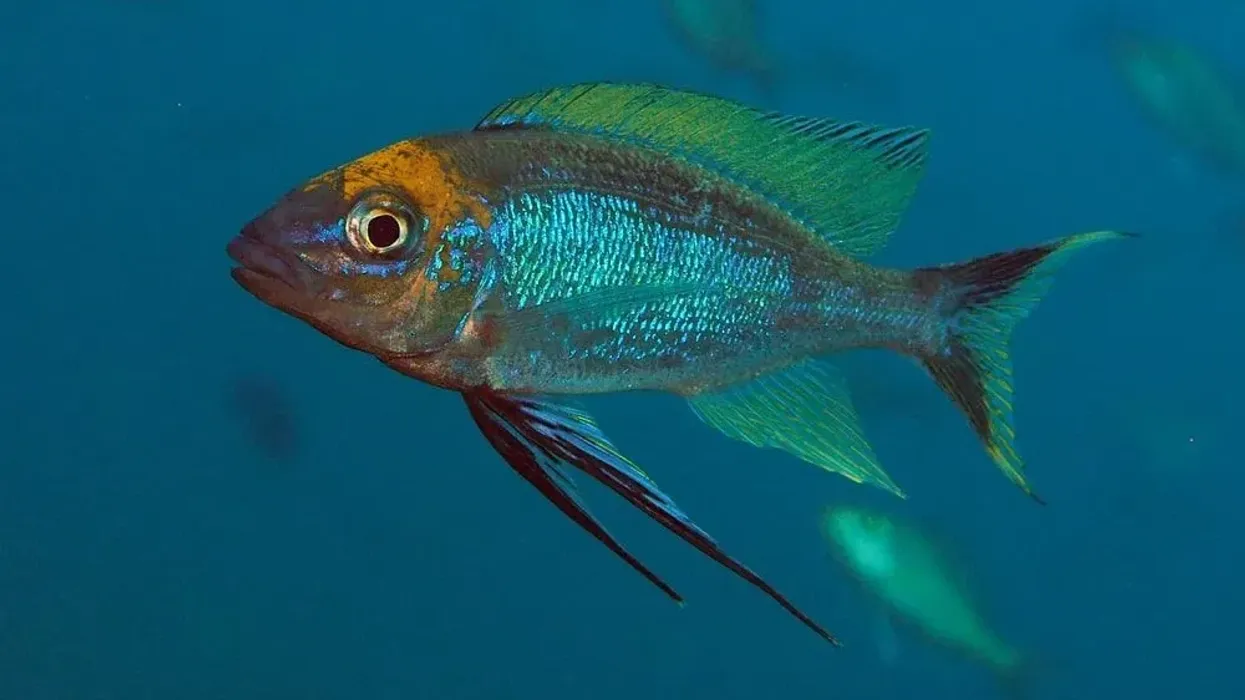Pygmy hatchetfish Carnegiella (Carnegiella Myersi) is a species of hatchetfish family Gasteropelecidae, are peaceful in nature and do well on community tank are native to Peru.
The smallest species of hatchetfish unique addition to a specialty community or aqua caped tank, the Carnegiella myersi pygmy hatchetfish is primarily found in slow moving shallow waters, the origin being Peruvian Amazon basin.
Their diet includes quality food like flakes, insects and worms.
These fish of family Gasteropelecidae are commonly referred to as freshwater fishes (freshwater hatchetfishes) because sometimes said to be capable of propelled flight above the water surface by beating their pectoral fins. The rounded keel is shallower than related species, giving this fish a distinctive elongate pygmy hatchetfish profile.
They are called flying fish as they have really strong fins that help them jump high in the air to catch their prey above the water layer. When they feel they are in trouble they jump out of the water.
For more relatable content, check out these channel catfish facts and rockfish facts for kids.
Pygmy Hatchetfish Interesting Facts
What type of animal is a pygmy hatchetfish?
Carnegiella myersi is a type of small size peaceful freshwater fish recommended to be kept in groups of 8-10 fishes of same species. Few other freshwater fish are freshwater mussels, freshwater drum and freshwater butterflyfish.
What class of animal does a pygmy hatchetfish belong to?
Pygmy hatchetfish Carnegiella is of class Actinopterygii fish of phylum chordata belonging to family Gasteropelecidae.
How many pygmy hatchetfishes are there in the world?
The definite number of pygmy hatchetfish present across the world is unknown.
Where does a pygmy hatchetfish live?
It is common for pygmy hatchetfish Carnegiella to live in woodland streams. Peruvian Amazon basin- the type locality is a creek near Yurimaguas, Peru.
Their second population known from Bolivia, is deeper bodied that the Peruvian Amazon population. Several species of hatchetfishes can also be found in subtropical and temperate, shallow waters of the Indian Ocean, Atlantic Ocean, and the Pacific Ocean and are called the marine hatchetfish. They also prefer acidic waters in the wild.
What is a pygmy hatchetfish's habitat?
Pygmy hatchetfish habitat includes warm, shaded, clear, and slightly acidic water and unlike other hatchet species, they spend much of their quality time below the surface mid water column unless they come out for feeding. They can be found in shaded and small shallow woodland streams in the forest.
Common or freshwater fish are shy and must take refuge in floating plants or greens in the wild.
Who do pygmy hatchetfishes live with?
The Carnegiella myersi are known to live in groups of around 8-10 or more in the aquarium and require excellent water quality and peaceful tankmates. These fish thrive in tank or aquarium.
How long does a pygmy hatchetfish live?
The Carnegiella myersi fish of this genus generally live up to three years, if pygmy hatchetfish care should be taken seriously they may live up to five years.
How do they reproduce?
Carnegiella myersi cannot bred in captivity, its hard to differentiate between male and female hatchetfish as these flying fish do not exhibit sexual dimorphism.
These fish scatter their eggs, as they stay on the water surface and hide behind plants floating on the surface; thus, they love to deposit and lay their eggs on the plants floating on the surface. The eggs hatch in approximately two days, the male and female should be kept in different tank as they might eat the eggs.
It is recommended not to breed silver hatchetfish.
What is their conservation status?
Carnegiella myersi are least concern, they rarely jump in the aquarium when being chased with a net. They accept all kind of water parameters.
Pygmy Hatchetfish Fun Facts
What do pygmy hatchetfishes look like?
Pygmy hatchetfish shows frontal bone longitudinally corrugated with a strong longitudinal ridge, posttemporal and supracleithrum fused into a single bone, pectoral fins and associated bones minute lateral line extending ventro-posteriorly for approaching the anal-fin insertion.
They possess 0-2 or 3 scales behind its head and one or very few scales on the caudal-fin base, 10-17 dorsal-fin rays, 22-44 anal-fin rays.
The Bolivian form of the species is deeper bodied than the ones from the Peruvian Amazon.
The Carnegiella myersi fish find food and distract predators with the help of light as they are not so big in size.
This species eat small dried food, frozen foods, insects, mosquitoes. Others have different colors as they accept light, temperature, pH levels, and diet.

*We've been unable to source images of Pygmy Hatchetfish and have used images of Marble Hatchetfish instead. If you are able to provide us with royalty-free images of Pygmy Hatchetfish, we would be happy to credit you. Please contact us at hello@kidadl.com.
How cute are they?
Pygmy hatchetfish for sale is recommended as they are small in size as well as have a cute appearance, are peaceful in nature. Rounded keel, covered with black, grey tints. They may also be kept as pet in aquarium or community tank in groups.
How do they communicate?
It is not much known about Carnegiella myersi communication process but they communicate through their actions and behavior and their fin movements. Make sure that their companion fish species do not dwarf and attack these peaceful fish.
How big is a pygmy hatchetfish?
There are different types of Carnegiella myersi species, where some are dwarf and some are large in size, but generally they are between 1.25-2.5 in (3.2-6.5 cm) in length. They are five times bigger than a parasitic bee.
How fast can a pygmy hatchetfish swim?
Characins are usually known for swimming on the water surface at an excellent speed in search of their prey. They can lean upwards up to 5 ft (1.5 m) high to catch their prey.
Their exact speed is not known still but they refuge beneath the floating plants on the surface. They can swim in a ninja like speed with the help of their pectoral fins.
How much does a pygmy hatchetfish weigh?
Their actual weight is not known but it should be relatively less, judging by their small appearance.
What are the male and female names of the species?
Characins do not have separate name for male and female they are simply called pygmy hatchetfish male and pygmy hatchetfish female.
What would you call a baby pygmy hatchetfish?
Baby species of myersi hatchetfish do not have any specific name they are simply known as young hatchetfish.
What do they eat?
Pygmy hatchetfish diet consists of carnivores such as small planktons, small insects above the water level, mosquito larvae, crustaceans, and small tiny worms, shrimps, crustaceans, and insects. Those kept in aquarium or fish tanks can be fed with small dried food, live and frozen small insects like nauplii, daphnia, moina, fruit flies, fish flakes.
They jump in the air to catch their prey. It is recommended to keep patience while feeding them.
These peaceful species remain in search of meaty foods that can be given to them. Silver Hatchetfish, which is another species of this genus, their diet mainly contains of foods like frozen small insects, they must be given flake foods so they remain satisfied.
Are they dangerous?
These freshwater myersi species of Peru are not dangerous, on the basis of compatibility, they are shy and peaceful in nature and hence they are easily dominated by other fish species which are bigger in size, if they are kept in the same tank as tankmates.
These species of myersi are not at all dangerous for humans and these parameters can be used to keep them in tank or aquarium.
Would they make a good pet?
Yes, they can make a good pet and accept their survival when kept in groups. They can be kept in tanks and aquarium.
Leaving the fish tank open during darkness is likely to result in one or more hatchetfish on the floor by morning, so clearly they do jump thats why the tank should be covered.
A lot of care is required when these peaceful myersi kept as pet, the volume of water, lighting should be moderate, ph level of water should be 5.5-6.5, temperature and must be checked regularly. Feeding alone is not a big deal, but feeding and breeding together can be an issue for them.
Did you know...?
The myersi species are very peaceful in nature and can live in tank as well as aquarium. It can regulate the amount of lighting from its own body through bioluminescent light organs. It helps them camouflage with their surroundings and helps them escape from their predators by the lighting method through their light patterns.
A marbled hatchetfish species can jump up to 5 ft (1.5 m) high in water, almost capable of flying! The volume of water should be deep, minimum tank size to keep them must be 15 gal (57 L). In the wild they prefer acidic water and shallow waters, care must be paid to the water parameters.
How have pygmy hatchetfish adapted to their environment?
Pygmy hatchetfish adaptation origin is from South America and North America. There are different types of hatchetfish living in tropical as well subtropical regions. Diet of all the hatchetfishes are almost same as well as they accept the water parameters in which they are kept.
Why is it called a pygmy hatchetfish?
Weitzman did a lot of study in these freshwater fishes. They got their name from their unique hatchet-like appearance. The origin is in amazon Peruvian and North - South America.
Here at Kidadl, we have carefully created lots of interesting family-friendly animal facts for everyone to discover! For more relatable content, check out these bonito fish facts and koi facts pages.
You can even occupy yourself at home by coloring in one of our free printable pygmy hatchetfish coloring pages.









